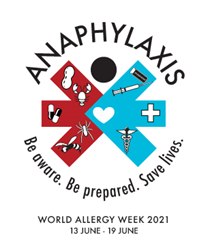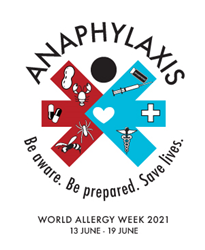
“We could save lives, if everyone would learn the early signs of anaphylaxis and be able to recognize it and respond fast.”
MILWAUKEE (PRWEB)
May 13, 2021
World Allergy Organization (WAO) will host World Allergy Week from June 13 to 19, 2021, to raise awareness of anaphylaxis risks, triggers, treatment, and prevention. Anaphylaxis is a serious allergic reaction that comes on suddenly and severely after exposure to allergens, most commonly food, drugs, and insect venom, and can be fatal.
Anaphylaxis is an allergic reaction that involves the airway, breathing, or circulation (ABC). Features of anaphylaxis include asthma-like symptoms, low blood pressure/fainting, confusion – usually in the context of more typical symptoms of a mild allergic reaction, such as hay fever-like symptoms, itchy skin rash (hives), swelling of the lips or face, abdominal pain or vomiting. Anaphylactic shock is the most severe presentation, in which insufficient blood is circulating around the body, resulting in collapse.
“We could save lives, if everyone would learn the early signs of anaphylaxis and be able to recognize it and respond fast,” according to Motohiro Ebisawa, MD, PhD, Sagamihara National Hospital, Sagamihara, Japan, who is President of WAO. “Anaphylaxis does not have to be severe or fatal, if it is identified and treated immediately.”
“Immediate injection of intramuscular epinephrine (adrenaline) at the first sign of anaphylaxis, and calling for an ambulance, is the most effective way to treat anaphylaxis. Epinephrine (adrenaline) is available as intramuscular auto-injectors or pre-filled syringes,” according to Paul J. Turner, MD, PhD, Imperial College London, United Kingdom. “However, not all parts of the world have epinephrine (adrenaline) for patients to keep as rescue medication – something we must try and address.”
“People at risk of anaphylaxis should work with their allergy/immunology specialist to learn how and when to self-inject epinephrine (adrenaline), as well as to develop an emergency plan. They must carry both the medicine and plan with them at all times,” according to Luciana Kase Tanno, MD, PhD, University Hospital of Montpellier and Desbrest Institute of Epidemiology and Public Health, INSERM, University of Montpellier, France.
International allergy experts will present “SToP Anaphylaxis”, a two hour-webinar hosted by WAO on June 17, 2021, at 8:00 a.m. EDT (New York). The program will cover risks and triggers, identification, treatment, and prevention of anaphylaxis, and include a question-and-answer session. Click here to find your local time: https://www.timeanddate.com/worldclock/converter-classic.html. Find details about the WAO webinar and other resources at: http://www.worldallergyweek.org.
To find a professional allergy/immunology member society of WAO in your country or region, visit: http://www.worldallergy.org/about-wao/member-societies.
Note to journalists and physicians: See “World Allergy Organization Anaphylaxis Guidance 2020”, World Allergy Organization Journal 2020;13(10):100472 (30 October). DOI: https://doi.org/10.1016/j.waojou.2020.100472
About the World Allergy Organization
The World Allergy Organization (WAO) is an international alliance of 104 regional and national allergy, asthma and immunology societies. Through collaboration with its Member Societies WAO provides a wide range of educational and outreach programs, symposia and lectureships to allergists/immunologists around the world and conducts initiatives related to clinical practice, service provision, and physical training in order to better understand and address the challenges facing allergists/immunologists worldwide. (http://www.worldallergy.org)
Share article on social media or email:

